Water-Filling Characteristics and Water Source of Weakly Rich Water and Weakly Conducting Water Aquifers in the Changxing Formation after Mining Damage
Abstract
1. Introduction
2. Overview of the Mining Area
2.1. Basic Information of the Mining Area
2.2. Introduction to Geology and Hydrogeology of the Mining Area
2.3. Hydrogeological Characteristics of Limestone in the Changxing Formation
2.4. Water-Inrush Situation in Coal Mines in the Mining Area
3. Research on Water-Inrush Sources
3.1. Spatial and Temporal Distribution Characteristics of Water Inrush in Working Faces
3.2. Chemical Analysis of Water Inflow in the Working Face
3.3. Analysis of the Correlation between Mine Water Inflow and Atmospheric Precipitation
4. Mechanism of Underground Stope Replenishment through Atmospheric Precipitation
5. Conclusions
- (1)
- The weak water-rich and weakly permeable aquifers in the Changxing Formation limestone were interconnected by cracks and caves formed under mining conditions, enhancing the water richness of the Changxing Formation limestone and transforming it into a huge water storage space. This phenomenon often leads to water-inrush incidents in deep mines.
- (2)
- A hydrochemical connection existed between surface water, the Changxing Formation limestone aquifer water, and mine inflow water. The water quality of mine water and surface water was consistent, with the original Changxing Formation limestone water exhibiting a transitional between the two.
- (3)
- Mining-induced damage to the Changxing Formation limestone expanded its damage range and water storage capacity, effectively reducing the distance and increasing the intensity with which atmospheric precipitation replenished the mining area. Therefore, atmospheric precipitation emerged as the main source of water influx in existing mines.
- (4)
- The study investigated the mechanism through which atmospheric precipitation replenishes deep mines through the Changxing Formation limestone reservoir and water-conducting channels. However, there remains a lack of in-depth research on the formation mechanism of the Changxing Formation limestone water-conducting channels. Future research on the formation mechanism of these channels will be pivotal in preventing and controlling atmospheric precipitation-induced water damage in deep mines.
Author Contributions
Funding
Data Availability Statement
Conflicts of Interest
References
- Song, Z. The Impact and Prediction Analysis of Atmospheric Precipitation on Coal Mine Water Inflow in Southwest Mountain Areas—Taking Xiaotun Mine as an Example. Master’s Thesis, China University of Mining and Technology, Xuzhou, China, 2019. [Google Scholar]
- Suo, J.; Qin, Q.; Wang, W.; Li, Z.; Huang, C.; Xu, Y.; Chen, Z. Disastrous Mechanism of Water Burst by Karst Roof Channel in Rocky Desertification Mining Area in Southwest China. Geofluids 2022, 2022, 7332182. [Google Scholar] [CrossRef]
- Liu, J.; Zhao, Y.; Tan, T.; Zhang, L.; Zhu, S.; Xu, F. Evolution and modeling of mine water inflow and hazard characteristics in southern coalfields of China: A case of Meitanba Mine. Int. J. Min. Sci. Technol. 2020, 32, 513–524. [Google Scholar] [CrossRef]
- Wang, H. Prediction of Water Inflow in Huoshaopu Coal Mine in Panxian Basin, Guizhou Province. China Coal Geol. 2019, 31, 44–51. [Google Scholar]
- Shi, X.; Zhang, W. Characteristics of an underground stope channel supplied by atmospheric precipitation and its water disaster prevention in the karst mining areas of Guizhou. Sci. Rep. 2023, 13, 15892. [Google Scholar] [CrossRef]
- Li, L. Prediction of Mine Pit Water Inflow in Qinglong Coal Mine, Qianxi, Guizhou. Coal Technol. 2015, 34, 228–230. [Google Scholar]
- Mo, L.; Fan, J.; Zhang, G.; Liu, F. Study on inorganic and organic hydrochemical characteristics and water source discrimination in Xiaotun coal mine. Energy Environ. Prot. 2019, 41, 94–99+104. [Google Scholar]
- Zhang, W. Analysis of water drilling technology for exploring top plate sandstone in the 1013 working face of Yushuquan Coal Mine. Shandong Ind. Technol. 2015, 21, 41. [Google Scholar]
- Liang, S. Research on the Distribution Characteristics of Confined Water and Safe Mining Techniques in the Qianbei Mining Area. Ph.D. Thesis, China University of Mining and Technology (Beijing), Beijing, China, 2013. [Google Scholar]
- Li, Z.; Li, S.; Du, F.; Wang, W.; LI, J.; Jiao, Y.; Fan, X. Research on the development law of karst caves on water conducting fractures under the influence of mining in Southwest Karst Mining Areas. Coal Sci. Technol. 2023, 51, 106–117. [Google Scholar]
- Zheng, G. Analysis of the Formation mechanism of water and gangue collapse accidents in Tenglong Coal Mine, Guizhou Province. China Coal Geol. 2024, 36, 43–46+5. [Google Scholar]
- Jin, M.; Yao, X.; Zhang, W.; Qin, X.; Yang, X. Research on the Formation Mechanism and Comprehensive Prevention and Control Technology of Separation Water in Changxing Formation of Qianbei Coalfield. Coal Technol. 2023, 42, 128–132. [Google Scholar]
- Li, B.; Wei, T.; Liu, Z. Construction of evaluation index system for water abundance of karst aquifers and risk assessment of water inrush on coal seam roof in Southwest China. J. China Coal Soc. 2022, 47, 152–159. [Google Scholar]
- Shi, X.; Qian, Z.; Li, T.; Jiang, Z.; Jiang, T. Study on the occurrence characteristics of karst groundwater in coal measures Roof. Coal Eng. 2017, 49, 63–66. [Google Scholar]
- Yao, G.; Chen, Z.; Xiang, X. Research on the characteristics of water barrier damage and surface water infiltration under coal mining conditions in karst mountainous areas. Hydrogeol. Eng. Geol. 2012, 39, 16–20+25. [Google Scholar]
- Wang, Z.; Zhang, Q.; Zhang, W. A novel collaborative study of abnormal roof water inrush in coal seam mining base d on strata separation and wing crack initiation. Eng. Fail. Anal. 2022, 142, 106762. [Google Scholar] [CrossRef]
- Long, T.; Hou, E.; Xie, X.; Fan, Z.; Tan, E. Study on the damage characteristics of overburden of mining roof in deeply buried coal seam. Sci. Rep. 2022, 12, 11141. [Google Scholar] [CrossRef]
- Xiao, L.; Li, F.; Niu, C.; Dai, G.; Qiao, Q.; Lin, C. Evaluation of Water Inrush Hazard in Coal Seam Roof Based on the AHP-CRITIC Composite Weighted Method. Energies 2023, 16, 114. [Google Scholar] [CrossRef]
- Liu, H.; Deng, K.; Zhu, X.; Jiang, C. Effects of mining speed on the developmental features of mining-induced ground fissures. Bull. Eng. Geol. Environ. 2019, 78, 6297–6309. [Google Scholar] [CrossRef]
- Li, X.; Ji, D.; Han, P.; Li, Q.; Zhao, H.; He, F. Study of water-conducting fractured zone development law and assessment method in longwall mining of shallow coal seam. Sci. Rep. 2022, 12, 7994. [Google Scholar] [CrossRef]
- Zhai, W.; Li, W.; Huang, Y.; Ouyang, S.; Ma, K.; Li, J.; Gao, H.; Zhang, P. A Case Study of the Water Abundance Evaluation of Roof Aquifer Based on the Development Height of Water-Conducting Fracture Zone. Energies 2020, 13, 4095. [Google Scholar] [CrossRef]
- Wang, W.; Li, Z.; Du, F.; Cao, Z.; Li, G. Study of Roof Water Inrush Control Technology and Water Resources Utilization During Coal Mining in a Karst Area. Mine Water Environ. 2023, 42, 546–559. [Google Scholar] [CrossRef]
- Wang, B.; Zhou, D.; Zhang, J.; Liang, B. Research on the dynamic evolution law of fssures in shallow-buried and short-distance coal seam mining in Lijiahao Coal Mine. Sci. Rep. 2023, 13, 5625. [Google Scholar] [CrossRef] [PubMed]
- Zhu, C.; Cui, D.; Zhou, Z.; Li, Q.; Huang, Y. Similar simulation of mining-induced fissure development law and cave destruction character when mining in karst area. J. Undergr. Space Eng. 2019, 15, 93–100+124. [Google Scholar]
- Liu, Q.; Zhou, C.; Ma, D.; Liu, Y.; Wang, G.; Huang, Z. Evolution of Water-Conducting Fracture in Weakly Cemented Strata in Response to Mining Activity: Insights from Experimental Investigation and Numerical Simulation. Water 2023, 15, 4173. [Google Scholar] [CrossRef]
- Chen, W.; Zeng, C.; Gong, X.; Tai, Z.; Deng, J.; Yang, M. Hydrological and hydrochemical regime of a typical subterraneous river in a deep canyon karst area: A case study in the Santang underground river, Guizhou. Hydrogeol. Eng. Geol. 2022, 49, 19–29. [Google Scholar] [CrossRef]
- Han, J.; Gao, J.; Du, K.; Chen, M.; Jiang, B.; Zhang, K. Analysis of hydrochemical characteristics and formation mechanismin coal mine underground reservoir. Coal Sci. Technol. 2020, 48, 223–231. [Google Scholar]
- Bian, Z.; Cui, Y.-J.; Li, J.; Du, J.-G. Quality Assessment and Hydrogeochemistry of Surface Water in the Liujiang Basin, Hebei Province. Bull. Mineral. Petrol. Geochem. 2019, 38, 953–960. [Google Scholar] [CrossRef]
- Deshmukh, K.K. Impact of Human Activities on the Quality of Groundwater from Sangamner Area, Ahmednagar District, Maharashtra, India. Int. Res. J. Environ. Sci. 2013, 2, 66–74. [Google Scholar]
- Yang, J.; Cai, Y. Analysis of dynamic influencing factors of mine water inflow—Taking a coal mine in Guizhou as an example. Water Conserv. Sci. Technol. Econ. 2021, 27, 61–65+76. [Google Scholar]
- Wang, S. Research progress of precipitation infiltration supplement in karst aquifer system. J. China Hydrol. 2014, 34, 1–8. [Google Scholar] [CrossRef]
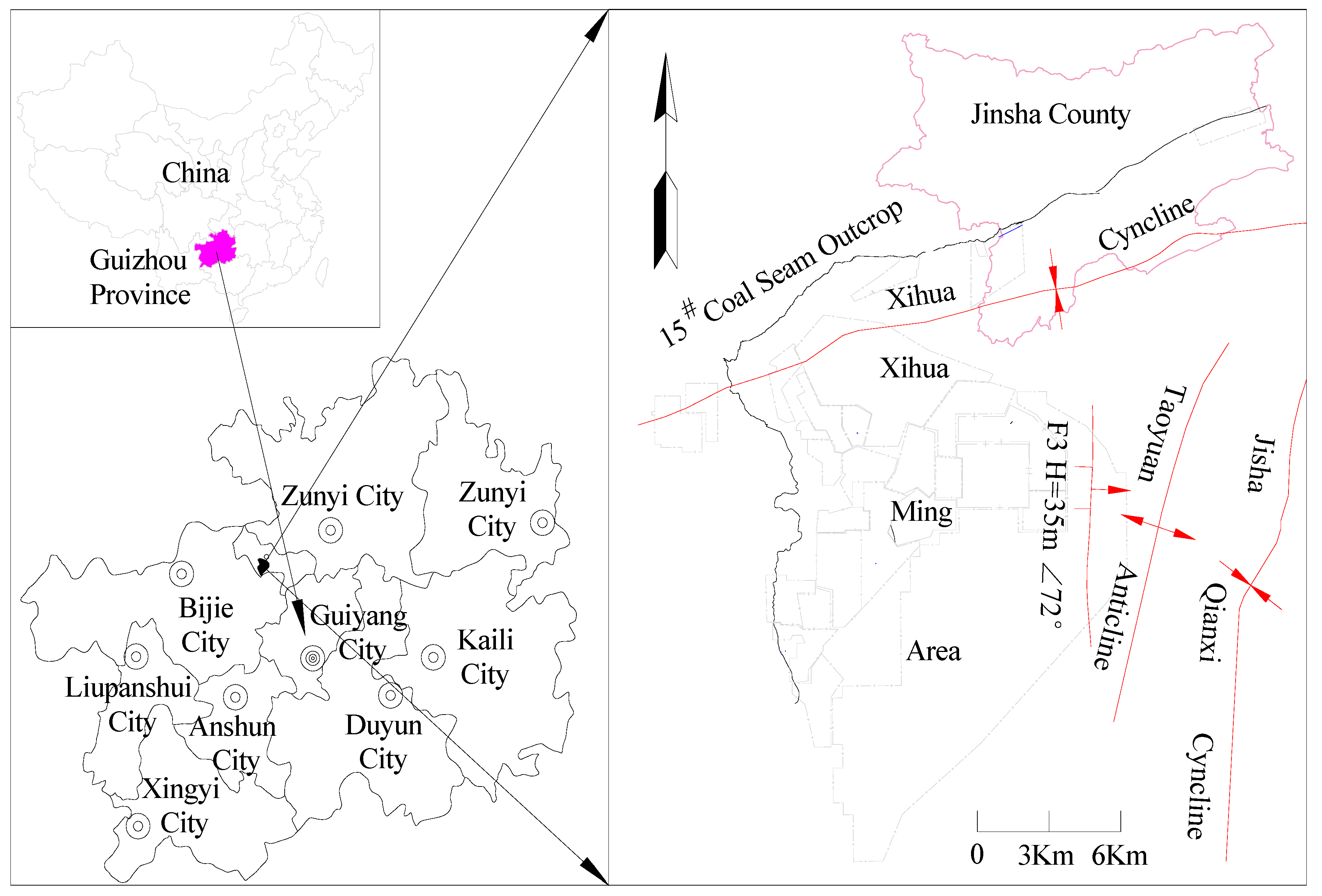
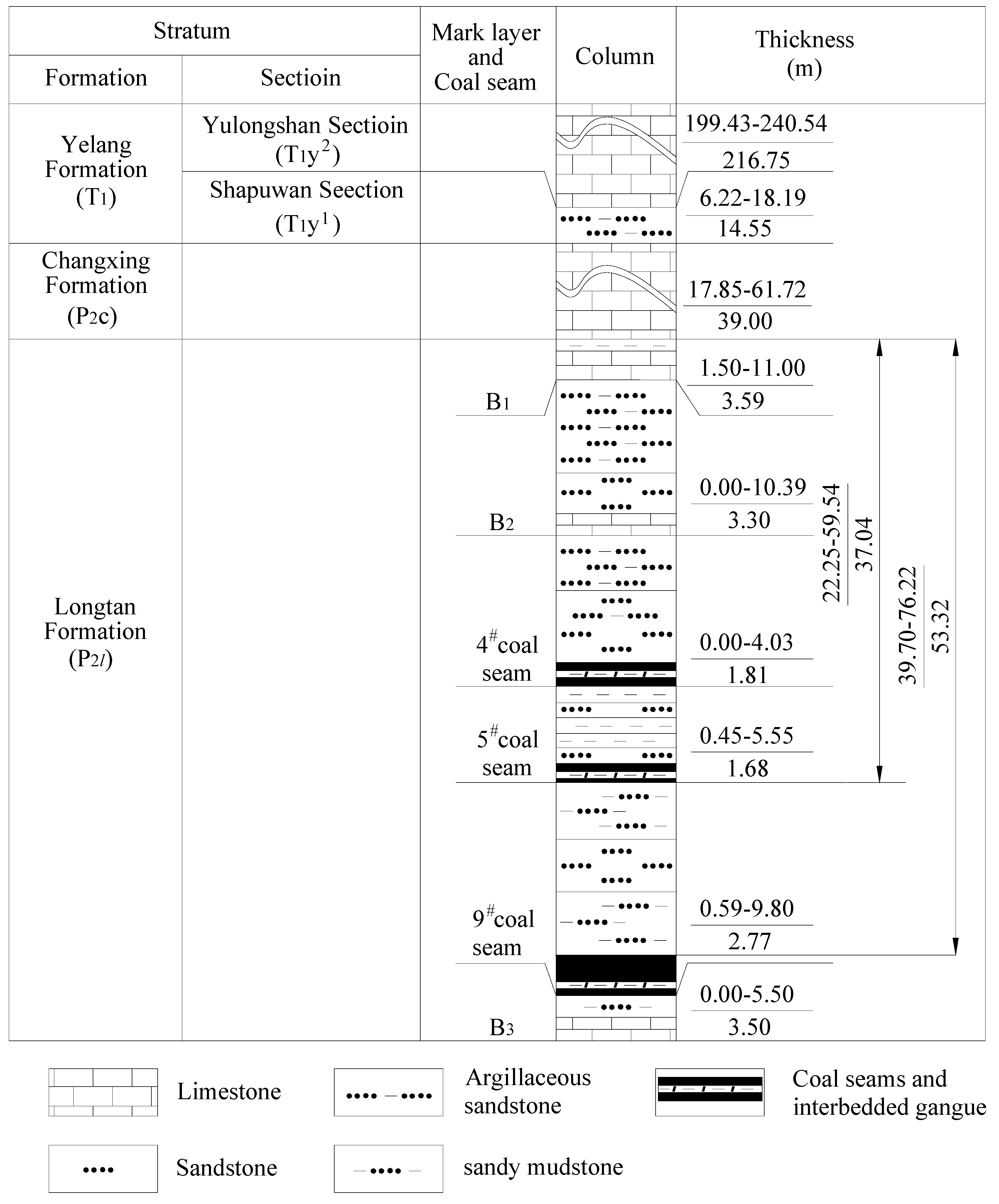


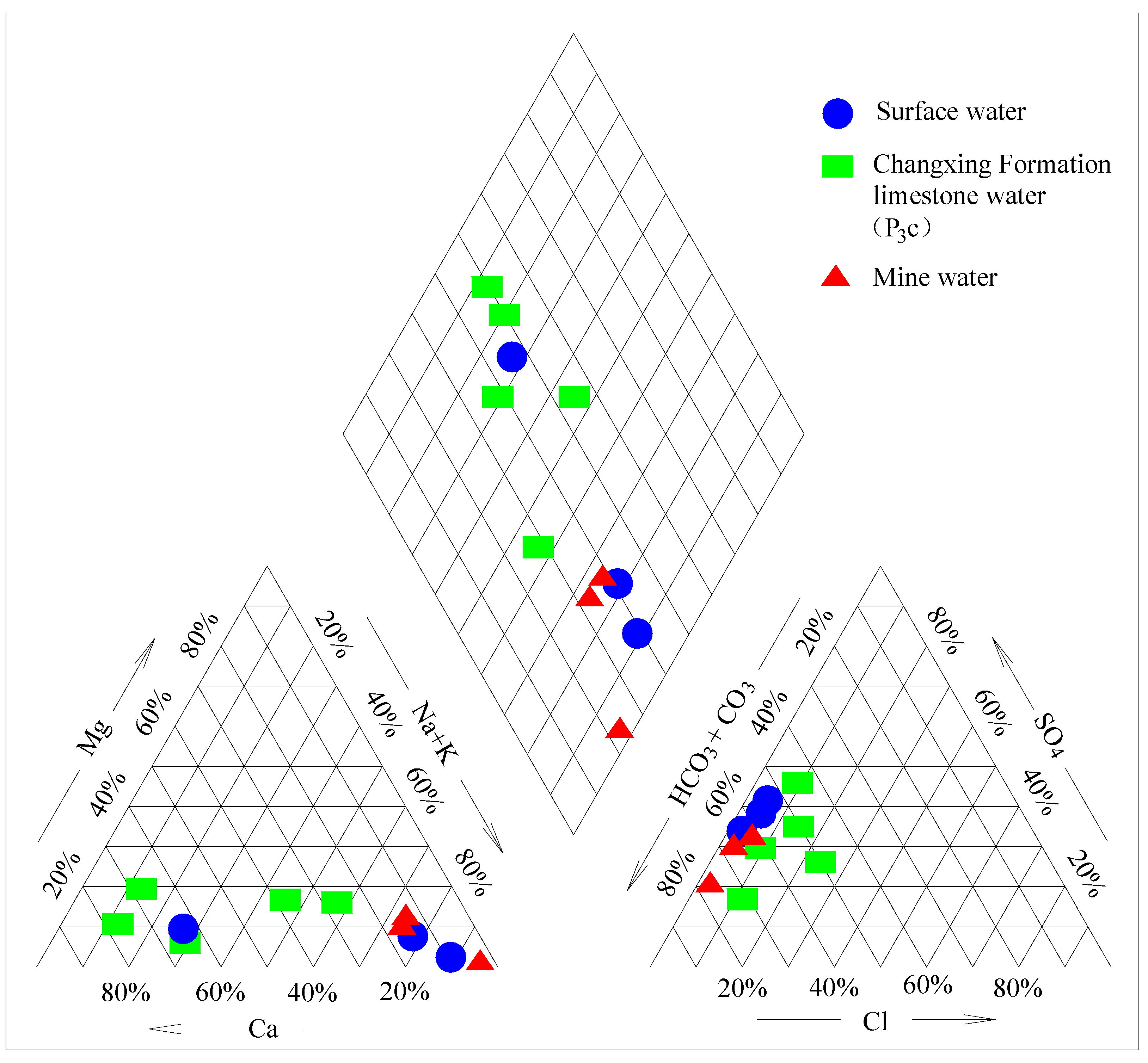

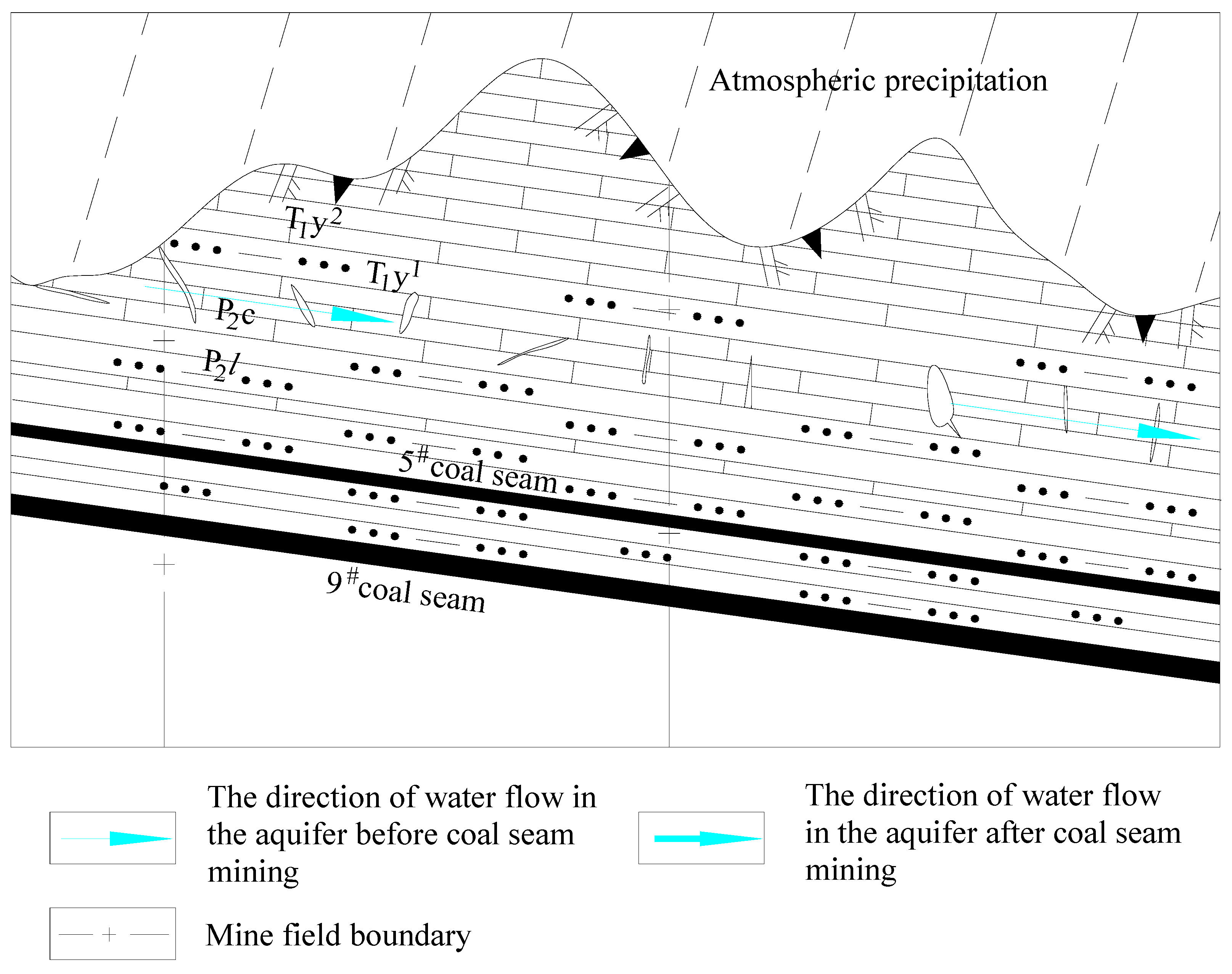
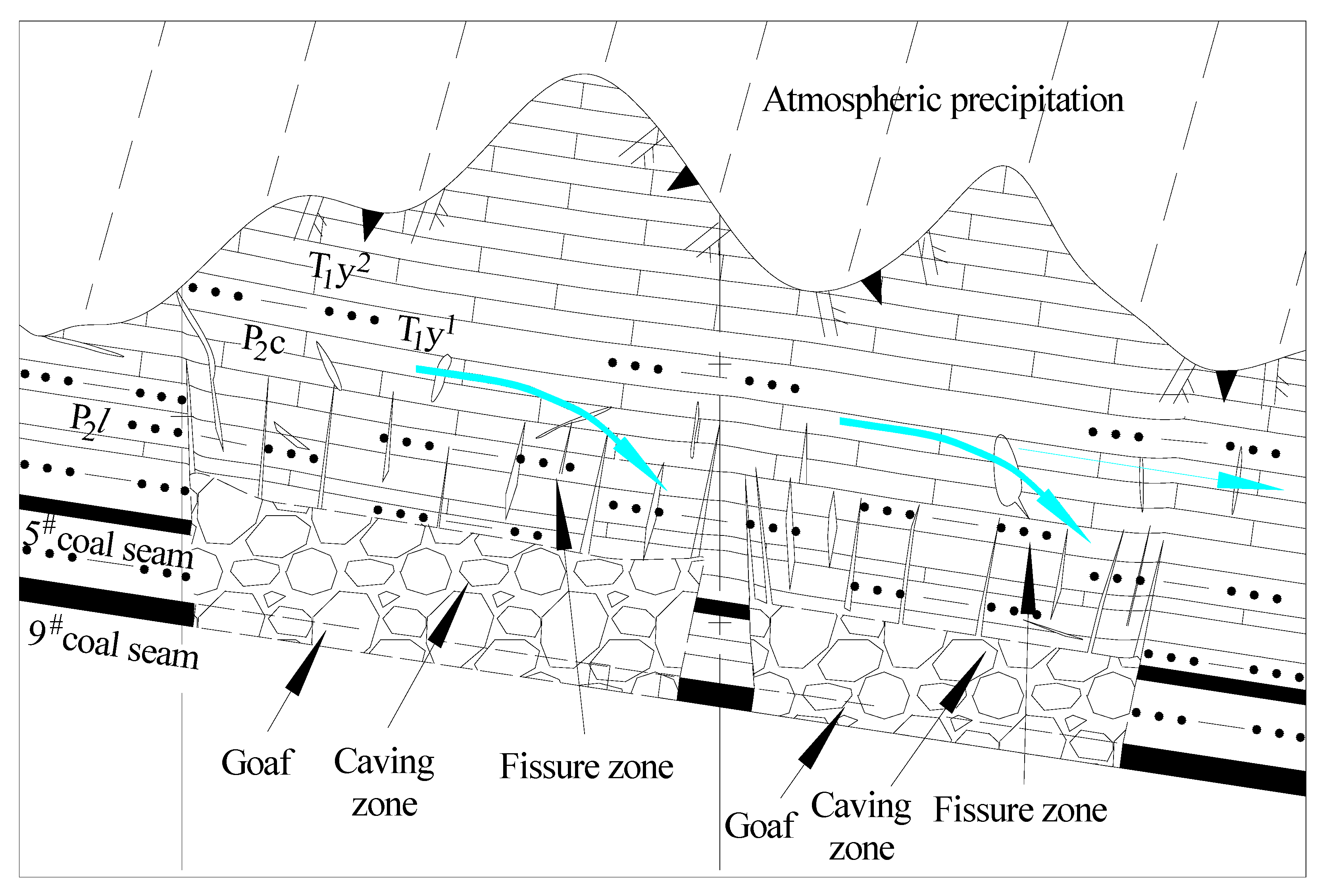
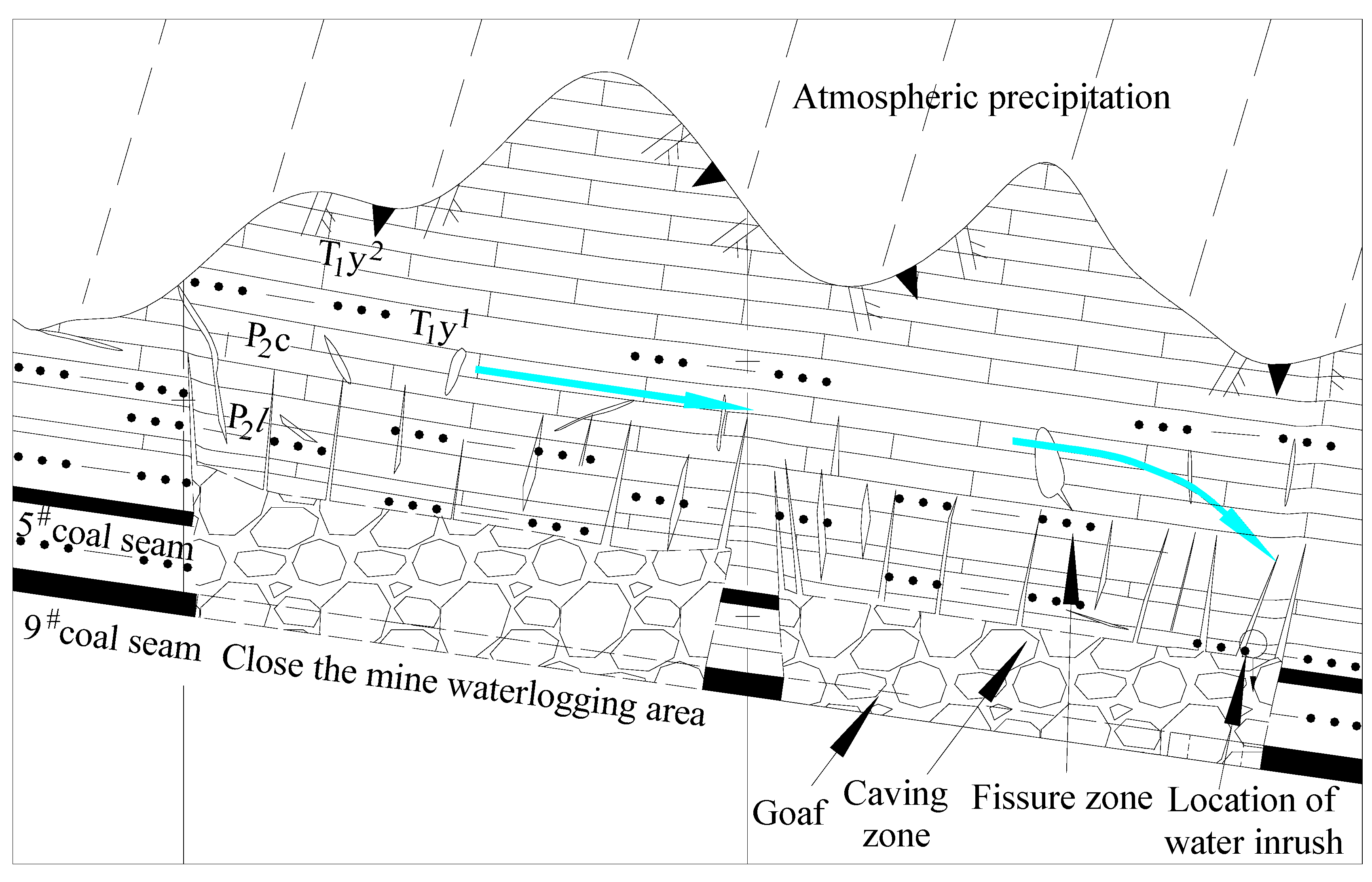
| Coal Mine | Water-Inrush Working Face | Location of Water Inrush | Structure of Water-Inrush Site and Working Face Situation | Water-Inrush Time (Year, Month, Day) | Sudden Water Volume (m3/h) | Elevation of Water-Inrush Point (Burial Depth) (m) | Water-Inrush Point Number (Marked in Figure 4) |
|---|---|---|---|---|---|---|---|
| Guiyuan Coal Mine | 10,903 | 276 m has been mined in the middle of the working face | Near the fault | 2016.6.16 | 280 | 783 (367) | G-1 |
| 10,901 | 80 m has been mined, and the lower part of the working face | Between two faults | 2019.2.30 | 160 | 833 (415) | G-2 | |
| 10,905 | 74 m has been mined, and the lower part of the working face | Near the fault | 2020.3.10 | 229 | 747 (421) | G-3 | |
| 143 m has been mined, and the lower part of the working face | Near the fault | 2020.5.12 | 150 | 751 (436) | G-4 | ||
| 425 m has been mined, and the lower part of the working face | Near the fault | 2020.11.8 | 290 | 776 (433) | G-5 | ||
| 10,908 | 247 m has been mined, and the lower part of the working face | Normal stratigraphic blocks (slow advancement of the working face) | 2021.10.13 | 210 | 808 (394) | G-6 | |
| 341 m has been mined, and the lower part of the working face | Normal stratigraphic blocks (slow advancement of the working face) | 2022.2.14 | 80 | 807 (439) | G-7 | ||
| 2093 | 161 m has been mined, and the lower part of the working face | Near the fault | 2019.7.15 | 150 | 728.5 (431.5) | G-8 | |
| 237 m has been mined, and the lower part of the working face | Near the fault | 2019.11.23 | 470 | 729.8 (432.6) | G-9 | ||
| 270 m has been mined, and the lower part of the working face | Near the fault | 2019.12.10 | 350 | 730.9 (439.4) | G-10 | ||
| Jinji Coal Mine | 1905 | 71 m has been mined, and the lower part of the working face | Normal stratigraphic blocks, near the near starting cut of the working face | 2018.12.20 | 200 | 877.5 (366.1) | J-1 |
| Lindong-Longfeng Coal Mine | 5914 | 202 m has been mined, and the lower part of the working face | Expose the fault location | 2019.7.22 | 160 | 979.3 (146.2) | L-1 |
| 365 m has been mined, and the lower part of the working face | Normal stratigraphic block, stop mining position | 2020.3.24 | 210 | 977.8 (127.4) | L-2 | ||
| Tenglong Coal Mine | 1091 | 163 m has been mined, and the upper part of the working face | 40 m normal stratigraphic block segment, 40 m away from the shorting cut of the nearby working face | 2020.4.19 | 80 | 1047.3 (342.7) | T-1 |
| 536 m has been mined, and the upper part of the working face | Normal geological blocks, slow mining in the working face | 2020.11.11 | 800 | 1047.4 (350.1) | T-2 | ||
| 10,903 | 465 m has been mined, and the lower part of the working face | Near the fault | 2022.6.19 | Collapse water and gangue | 993.4 (274.1) | T-3 |
| Water Sample Location | Surface Water (mg/L) | Changxing Formation (P3c) Limestone Water (mg/L) | Mine Water (mg/L) | |||||||||
|---|---|---|---|---|---|---|---|---|---|---|---|---|
| Cation | Ca2+ | 23.55 | 45.89 | 112.04 | 65.38 | 17.01 | 60.17 | 47.62 | 52.75 | 4.80 | 21.15 | 15.66 |
| Mg2+ | 4.20 | 14.73 | 10.20 | 8.60 | 6.15 | 3.40 | 8.19 | 14.14 | 1.46 | 8.07 | 8.55 | |
| Na+ | 257.83 | 280.60 | 54.79 | 15.54 | 38.90 | 30.05 | 10.60 | 72.93 | 344.00 | 115.00 | 96.50 | |
| K+ | 1.85 | 2.86 | 1.33 | 1.74 | 7.10 | 1.30 | 1.50 | |||||
| NH4+ | 0.05 | 0.16 | 0 | 0 | 1.02 | 0 | 0 | 0 | 2.4 | 1.0 | 0.52 | |
| Anion | HCO3+ | 469.61 | 558.68 | 288.85 | 142.54 | 137.53 | 163.66 | 106.90 | 192.09 | 642.17 | 249.27 | 227.40 |
| CO32+ | 7.24 | 4.34 | 0 | 0 | 0 | 0 | 0 | 0 | 45.57 | 0.00 | 0.00 | |
| SO42+ | 196.54 | 305.41 | 175.34 | 58.45 | 25.31 | 60.81 | 58.45 | 153.12 | 150.00 | 104.00 | 80.00 | |
| Cl+ | 27.76 | 9.75 | 15.07 | 39.36 | 12.87 | 13.51 | 18.19 | 22.12 | 17.29 | 13.59 | 6.31 | |
| NO3+ | 3.09 | 7.56 | 0.20 | 0 | 0.20 | 5.22 | 1.77 | 0.04 | 0.50 | 1.98 | 2.11 | |
| NO2+ | 0.03 | 0.62 | 0 | 0 | <0.12 | 0.06 | < 0.12 | 0.24 | 0.272 | <0.10 | 0.006 | |
| Total hardness (mg/L) | 77.06 | 175.24 | 321.82 | 200.27 | 102.72 | 164.21 | 152.65 | 189.98 | 86.05 | 86.05 | 74.31 | |
| Total dissolved solids TDS (mg/L) | 716.00 | 907.50 | 510.50 | 250.53 | 144.00 | 279.50 | 168.00 | 430 | 892.59 | 393.58 | 327.76 | |
| PH | 8.9 | 8.6 | 7.17 | 7.5 | 7.82 | 8.4 | 8.55 | 6.1 | 8.18 | 8.18 | 8.11 | |
| Water quality type | HCO3·SO4 -Na | HCO3·SO4 -Na | HCO3·SO4 -Ca·Na | HCO3·SO4 -Ca | HCO3 -Na·Ca | HCO3·SO4 -Ca·Na | HCO3·SO4 -Ca·Na | HCO3·SO4 -Na·Ca | HCO3 -Na | HCO3·SO4 -Na | HCO3·SO4 -Na | |
| Elevation (burial depth) (m) | 1171.2 | 1327.5 | 1072.8 | 829.70 (305.86) | 1364.46 (21.27) | 1038.00 (332.45) | 794.70 (322.12) | 979.3 (231.5) | 945 (450) | 776 (419) | 985 (172) | |
| Notes | Surface water 1 | Surface water 2 | Surface water 3 | 1707 Borehole in Linhua Coal Mine | 401 Borehole in Fuliyuan Coal Mine (near the outcrop) | 904 Borehole in Linhua Coal Mine | 402 Borehole in Guiyuan Coal Mine | B3509-2 Borehole in Anshenglongfeng Coal Mine | 10,908 Working face of Guiyuan Coal Mine | 10,905 Working face of Guiyuan Coal Mine | Water outlet point of Changxing Formation limestone in the main shaft of Guiyuan Coal Mine | |
Disclaimer/Publisher’s Note: The statements, opinions and data contained in all publications are solely those of the individual author(s) and contributor(s) and not of MDPI and/or the editor(s). MDPI and/or the editor(s) disclaim responsibility for any injury to people or property resulting from any ideas, methods, instructions or products referred to in the content. |
© 2024 by the authors. Licensee MDPI, Basel, Switzerland. This article is an open access article distributed under the terms and conditions of the Creative Commons Attribution (CC BY) license (https://creativecommons.org/licenses/by/4.0/).
Share and Cite
Shi, X.; Xu, G.; Zhu, S. Water-Filling Characteristics and Water Source of Weakly Rich Water and Weakly Conducting Water Aquifers in the Changxing Formation after Mining Damage. Appl. Sci. 2024, 14, 4018. https://doi.org/10.3390/app14104018
Shi X, Xu G, Zhu S. Water-Filling Characteristics and Water Source of Weakly Rich Water and Weakly Conducting Water Aquifers in the Changxing Formation after Mining Damage. Applied Sciences. 2024; 14(10):4018. https://doi.org/10.3390/app14104018
Chicago/Turabian StyleShi, Xianzhi, Guosheng Xu, and Shuyun Zhu. 2024. "Water-Filling Characteristics and Water Source of Weakly Rich Water and Weakly Conducting Water Aquifers in the Changxing Formation after Mining Damage" Applied Sciences 14, no. 10: 4018. https://doi.org/10.3390/app14104018
APA StyleShi, X., Xu, G., & Zhu, S. (2024). Water-Filling Characteristics and Water Source of Weakly Rich Water and Weakly Conducting Water Aquifers in the Changxing Formation after Mining Damage. Applied Sciences, 14(10), 4018. https://doi.org/10.3390/app14104018








